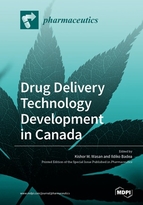Drug Delivery Technology Development in Canada
A special issue of Pharmaceutics (ISSN 1999-4923).
Deadline for manuscript submissions: closed (5 February 2019) | Viewed by 114228
Special Issue Editors
Interests: pharmaceutics; drug delivery; formulation; drug development; translational pharmacotherapy; lipid and lipoprotein metabolism; pharmacokinetics
Special Issues, Collections and Topics in MDPI journals
Interests: nucleic acid delivery; nanodiamonds; cationic gemini lipids; self-assembling nanoparticles; small angle X-ray scattering; flow cytometry; radiopharmaceuticals
Special Issues, Collections and Topics in MDPI journals
Special Issue Information
Dear Colleagues,
Canada continues to have a rich history of ground-breaking research in drug delivery within academic institutions, pharmaceutical industry and the biotechnology community. Drug delivery refers to approaches, formulations, technologies, and systems for transporting a pharmaceutical compound in the body as needed to safely achieve its desired therapeutic effect. It may involve scientific site-targeting within the body, or facilitating systemic pharmacokinetics; in any case, it is typically concerned with both quantity and duration of drug presence. Drug delivery is often approached through a drug's chemical formulation, medical devices or drug-device combination products. Drug delivery is a concept heavily integrated with dosage form and route of administration, the latter sometimes even being considered part of the definition.
Drug delivery technologies modify drug release profile, absorption, distribution and elimination for the benefit of improving product efficacy and safety, as well as patient convenience and compliance
Over the past 25 years, numerous Canadian-based biotechnology companies have been formed from the inventions conceived and developed within academic institutions that have led to the development of important drug delivery products that have enhanced the landscape of drug therapy in the treatment of cancer to infectious diseases.
This Special Issue serves to highlight and capture the contemporary progress of drug delivery within the prevailing Canadian context. We invite articles on all aspects of drug delivery sciences from pre-clinical formulation development to human clinical trials that bring to light the world-class research currently undertaken in Canada for this Special Issue.
Prof. Dr. Kishor M. Wasan
Prof. Dr. Ildiko Badea
Guest Editors
Manuscript Submission Information
Manuscripts should be submitted online at www.mdpi.com by registering and logging in to this website. Once you are registered, click here to go to the submission form. Manuscripts can be submitted until the deadline. All submissions that pass pre-check are peer-reviewed. Accepted papers will be published continuously in the journal (as soon as accepted) and will be listed together on the special issue website. Research articles, review articles as well as short communications are invited. For planned papers, a title and short abstract (about 100 words) can be sent to the Editorial Office for announcement on this website.
Submitted manuscripts should not have been published previously, nor be under consideration for publication elsewhere (except conference proceedings papers). All manuscripts are thoroughly refereed through a single-blind peer-review process. A guide for authors and other relevant information for submission of manuscripts is available on the Instructions for Authors page. Pharmaceutics is an international peer-reviewed open access monthly journal published by MDPI.
Please visit the Instructions for Authors page before submitting a manuscript. The Article Processing Charge (APC) for publication in this open access journal is 2900 CHF (Swiss Francs). Submitted papers should be well formatted and use good English. Authors may use MDPI's English editing service prior to publication or during author revisions.
Keywords
- Drug Delivery
- Pharmaceutics
- Drug Development
- Formulation and Dosage Form Development
- Translational Research
- Biologicals
- Small Molecules
- Clinical Trials
- Pharmacokinetics
- Medical Devices
- Route of Administration
Related Special Issues
- Advanced Pharmaceutical Science and Technology in Pharmaceutics (3 articles)
- Pharmaceutical Sciences in Canada in Pharmaceutics (41 articles)








